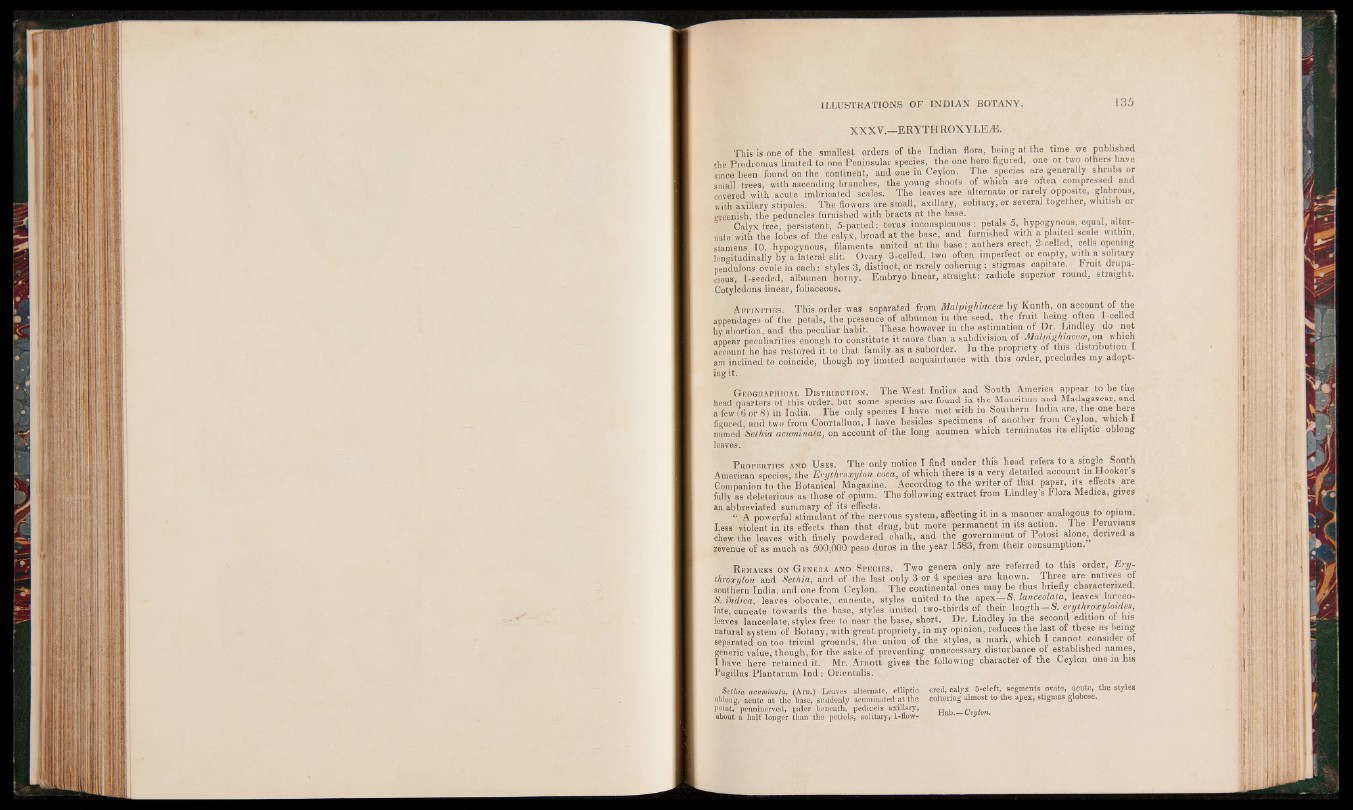
X X X V .— E R Y T H R O X Y L E Æ .
This is one of the smallest orders of the Indian flora, being at the time we published
the Prodromns limited to one Peninsular species, the one here figured, one or two others have
since been found on the continent, and one in Ceylon. The species are generally shrubs or
small trees, with ascending branches, the young shoots of which are often compressed and
covered with acute imbricated scales. The leaves are alternate or rare y opposite, glabrous,
with axillary stipules. The flowers are small, axillary, solitary, or several together, whitish or
ereenish, the peduncles furnished with bracts at the base.
6 Calyx free, persistent, 5-parted: torus inconspicuous: petals 5, hypogynous, equal, alternate
with the lobes of the calyx, broad at the base, and furnished with a plaited scale within,
stamens 10, hypogynous, filaments united at the base: anthers erect, 2-celled, cells opening
longitudinally by a lateral slit. Ovary 3-celled, two often imperfect or empty, with a solitary
pendulous ovule in each: styles 3, distinct, or rarely cohering : stigmas capitate. Fruit drupa-
cious, 1-seeded, albumen horny. Embryo linear, straight: radicle superior round, straight.
Cotyledons linear, foliaceous.
Affinities. This order was separated from Malpighiaceé by Kunth, on account; of the
appendages of the petals, the presence of albumen in the seed, the fruit being often 1-celled
by abortion, and the peculiar habit. These however m the estimation of Dr. Lindley do not
appear peculiarities enough to constitute it more than a subdivision of Malpighiacece on which
account he has restored it to that family as a suborder. In the propriety of this distribution I
am inclined to coincide, though my limited acquaintance with this order, precludes my adopting
it.
Geographical DISTRIBUTION. The West Indies and South America appear to be the
head quarters of this order, but some species are found in the Mauritius and Madagascar, and
a few (6 or 8) in India. The only species I have met with m Southern India are, the one
figured, and two from Courtallum, I have besides specimens of another from Ceylon, which I
named Sethia acuminata, on account of the long acumen which terminates its elliptic oblong
leaves.
P roperties and Uses. The only notice I find under this head refers to a single South
American species, the Erythroxylon coca, of which there is a very detailed account in Hooker s
Companion to the Botanical Magazine. According to the writer of that paper, its effects are
fully as deleterious as those of opium. The following extract from Lmdley s Flora Medica, gives
an abbreviated summary of its effects. . . .
“ A powerful stimulant of the nervous system, affecting it m a manner analogous to opium.
Less violent in its effects than that drug, but more permanent in its action. Ihe Peruvians
chew the leaves with finely powdered chalk, and the government of Potosi alone,^ derived a
revenue of as much as 500,000 peso duros in the year 1583, from their consumption.
R emarks on G enera and Species. Two genera only are referred to this order, Erythroxylon
and Sethia, and of the last only 3 or 4 species are known. Three are natives ot
southern India, and one from Ceylon. The continental ones may be thus briefly characterized.
S. Vndica, leaves obovate, cuneate, styles united to the apex—S. lanceolata, leaves lanceolate,
cuneate towards the base, styles united two-thirds of their length—S. erythroxyloides,
leaves lanceolate, styles free to near the base, short. Dr. Lindley in the second, edition ot his
natural system of Botany, with great propriety, in my opinion, reduces the last of these as being
separated on too trivial grounds, the union of the styles, a mark, which I cannot consider or
generic value, though, for the sake of preventing unnecessary disturbance of established names,
l have here retained it. Mr. Arnott gives the following character of the Ceylon one in his
Pugillus Plantarum ln d : Orientalis.
Sethia acuminata, (Arn.) Leaves alternate, elliptic ered, calyx 5-cleft, segments ovate, acute, the styles
oblong, acute at the base, suddenly acuminated at the cohering almost to the apex, stigmas globose,
point, penninerved, paler beneath, pedicels axillary, „ , Oevlnn
about a half longer than the petiols, solitary, 1-flow- * “